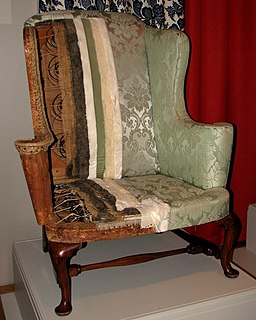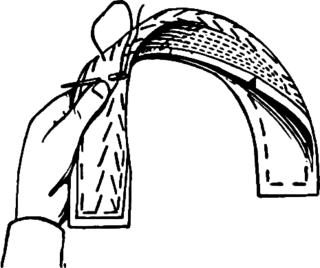Related Research Articles

Black tie is a semi-formal Western dress code for evening events, originating in British and American conventions for attire in the 19th century. In British English, the dress code is often referred to synecdochically by its principal element for men, the dinner suit or dinner jacket. In American English the equivalent term tuxedo is common. The dinner suit is a black, midnight blue or white two- or three-piece suit, distinguished by satin or grosgrain jacket lapels and similar stripes along the outseam of the trousers. It is worn with a white dress shirt with standing or turndown collar and link cuffs, a black bow tie, typically an evening waistcoat or a cummerbund, and black patent leather dress shoes or court pumps. Accessories may include a semi-formal homburg, bowler, or boater hat. For women, an evening gown or other fashionable evening attire may be worn.

A suit or lounge suit is a set of clothes comprising a suit jacket and trousers of identical textiles worn with a collared dress shirt, necktie, and dress shoes. It is considered informal wear in Western dress codes. The lounge suit originated in 19th-century Britain as a more casual alternative for sportswear and British country clothing. After replacing the black frock coat in the early 20th century as regular daywear, a sober one-coloured suit became known as a lounge suit. A black lounge suit for professional occasions became known as a business suit and belongs to the day dress of the semi-formal wear dress code.

A tailor is a tradesperson who makes, repairs, or alters clothing professionally, especially suits and men's clothing.

Upholstery is the work of providing furniture, especially seats, with padding, springs, webbing, and fabric or leather covers. The word also refers to the materials used to upholster something.
Drape suits are a 1930s British variation of the three-piece suit, in which the cut is full and 'drapes'. It is also known as the blade cut or London cut. The design of the athletic aesthetic of the drape suit is attributed to the London tailor Frederick Scholte. The new suit cut was softer and more flexible in construction than the suits of the previous generation; extra fabric in the shoulder and armscye, light padding, a slightly nipped waist, and fuller sleeves tapered at the wrist resulted in a cut with folds, or "drapes," front and back that created the illusion of the broad-shoulders and tight-waist "V" figure of the very fit.

A frock coat is a formal men's coat characterised by a knee-length skirt cut all around the base just above the knee, popular during the Victorian and Edwardian periods (1820s–1920s). It is a fitted, long-sleeved coat with a centre vent at the back and some features unusual in post-Victorian dress. These include the reverse collar and lapels, where the outer edge of the lapel is often cut from a separate piece of cloth from the main body and also a high degree of waist suppression around the waistcoat, where the coat's diameter round the waist is less than round the chest. This is achieved by a high horizontal waist seam with side bodies, which are extra panels of fabric above the waist used to pull in the naturally cylindrical drape. As was usual with all coats in the 19th century, shoulder padding was rare or minimal.

A dress shirt, button shirt, button-front, button-front shirt, or button-up shirt is a garment with a collar and a full-length opening at the front, which is fastened using buttons or shirt studs. A button-down or button-down shirt is a dress shirt which has a button-down collar – a collar having the ends fastened to the shirt with buttons.

Haircloth is a stiff, unsupple fabric typically made from horsehair and/or from the wooly hair of a camel. Although horsehair generally refers to the hair of a horse's mane or tail, haircloth itself is sometimes called horsehair. Horse or camel hair woven into haircloth may be fashioned into clothing or upholstery.

1850s fashion in Western and Western-influenced clothing is characterized by an increase in the width of women's skirts supported by crinolines or hoops, the mass production of sewing machines, and the beginnings of dress reform. Masculine styles began to originate more in London, while female fashions originated almost exclusively in Paris.

Lapels are the folded flaps of cloth on the front of a jacket or coat and are most commonly found on formal clothing and suit jackets. Usually they are formed by folding over the front edges of the jacket or coat and sewing them to the collar, an extra piece of fabric around the back of the neck.

Fashion in the years following World War II is characterized by the resurgence of haute couture after the austerity of the war years. Square shoulders and short skirts were replaced by the soft femininity of Christian Dior's "New Look" silhouette, with its sweeping longer skirts, fitted waist, and rounded shoulders, which in turn gave way to an unfitted, structural look in the later 1950s.

The most characteristic North American fashion trend from the 1930s to 1945 was attention at the shoulder, with butterfly sleeves and banjo sleeves, and exaggerated shoulder pads for both men and women by the 1940s. The period also saw the first widespread use of man-made fibers, especially rayon for dresses and viscose for linings and lingerie, and synthetic nylon stockings. The zipper became widely used. These essentially U.S. developments were echoed, in varying degrees, in Britain and Europe. Suntans became fashionable in the early 1930s, along with travel to the resorts along the Mediterranean, in the Bahamas, and on the east coast of Florida where one can acquire a tan, leading to new categories of clothes: white dinner jackets for men and beach pajamas, halter tops, and bare midriffs for women.

Perfecto is a secondary brand of "lancer fronted" leather motorcycle jackets designed by Irving Schott and manufactured by American clothing company Schott NYC. The first jacket was introduced in 1928, making it the first such styled leather motorcycle jacket. They were worn by such icons as Marlon Brando in the 1953 seminal movie The Wild One, by punk rock pioneers The Ramones in the 1970s and styled by fashion designers such as Jean Paul Gaultier in the 1980s.

Shoulder pads are a type of fabric-covered padding used in men's and women's clothing to give the wearer the illusion of having broader and less sloping shoulders. In the beginning, shoulder pads were shaped as a semicircle or small triangle, and were stuffed with wool, cotton or sawdust. They were positioned at the top of the sleeve, to extend the shoulder line. A good example of this is their use in "leg o' mutton" sleeves, or the smaller puffed sleeves which were revived at this time, and were based on styles from the 1890s. In men's styles, shoulder pads are often used in suits, jackets and overcoats, usually sewn at the top of the shoulder and fastened between the lining and the outer fabric layer. In women's clothing, their inclusion depends by the fashion taste of the day. Although from a non-fashion point of view they are generally for people with narrow or sloping shoulders, there are also quite a few cases in which shoulder pads will be necessary for a suit or blazer in order to compensate for certain fabrics' natural properties, most notably suede blazers, due to the weight of the material. They were popular additions to clothing during the 1940s, 1980s, early 1990s, late 2000s and early 2010s.

Pad stitches are a type of running stitch made by placing small stitches perpendicular to the line of stitching. Pad stitches secure two or more layers of fabric together and give the layers more firmness; smaller and denser stitches create more firmness. They may also be used to enforce an overall curvature of the layers.
A man's suit of clothes, in the sense of a lounge or business or office suit, is a set of garments which are crafted from the same cloth. This article discusses the history of the lounge suit, often called a business suit when featuring dark colors and a conservative cut.
Sewing is the craft of fastening or attaching objects using stitches made with needle and thread. Sewing is one of the oldest of the textile arts, arising in the Paleolithic Era. Although usually associated with clothing and household linens, sewing is used in a variety of crafts and industries, including shoemaking, upholstery, sailmaking, bookbinding and the manufacturing of some kinds of sporting goods. Sewing is the fundamental process underlying a variety of textile arts and crafts, including embroidery, tapestry, quilting, appliqué and patchwork.

In sewing, a seam is the join where two or more layers of fabric, leather, or other materials are held together with stitches. Prior to the invention of the sewing machine, all sewing was done by hand. Seams in modern mass-produced household textiles, sporting goods, and ready-to-wear clothing are sewn by computerized machines, while home shoemaking, dressmaking, quilting, crafts, haute couture and tailoring may use a combination of hand and machine sewing.

In sewing and tailoring, a lining is an inner layer of fabric, fur, or other material inserted into clothing, hats, luggage, curtains, handbags and similar items.

A suit jacket, also called a lounge jacket, lounge coat or suit coat, is a jacket in classic menswear that is part of a suit.
References
- ↑ Shapira, J.A. (14 March 2017). "How To Tell A Quality Suit: Fused Vs. Canvassed". He Spoke Style. Retrieved 2019-03-19.
- 1 2 "Suiting 101: An Introduction to Suit Jacket Construction". The Compass: A Style Journal by Black Lapel. blacklapel.com. 2013-02-21. Retrieved 2017-10-04.
- ↑ Banner, Bernadette (2020-03-04). "Actual Tailor Explains Pad Stitching for Perfect Collars & Lapels | Barbara of Royal Black Couture". YouTube. Archived from the original on 2021-12-17.
- 1 2 "Glossary of Men's Formal Wear Terms". SharpSense. Archived from the original on 2017-10-05. Retrieved 2017-10-04.
- ↑ Smith, Ray A. (28 October 2017). "Cheap Suits Get a High-Fashion Upgrade". Wall Street Journal.
- ↑ "The Suit That Couldn't be Copied". 11 July 2016.